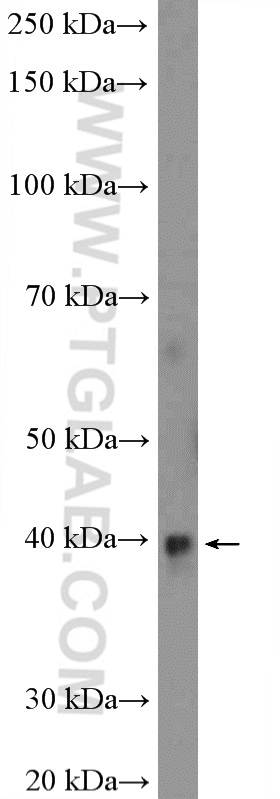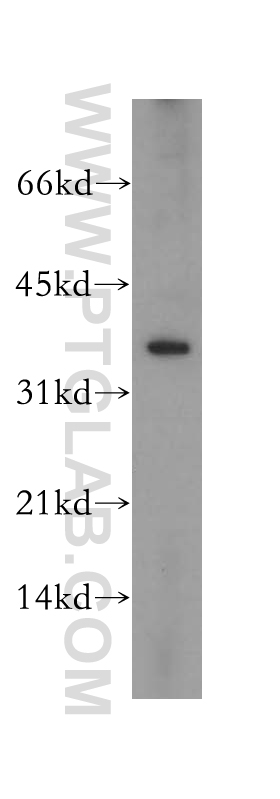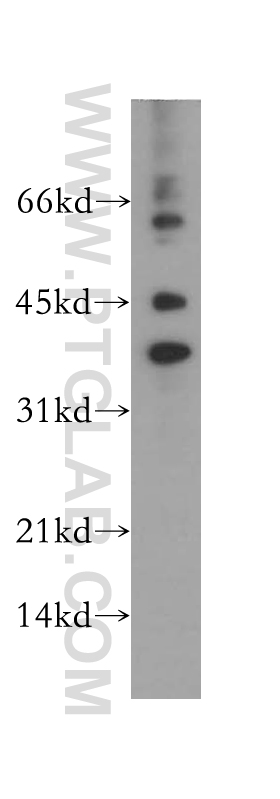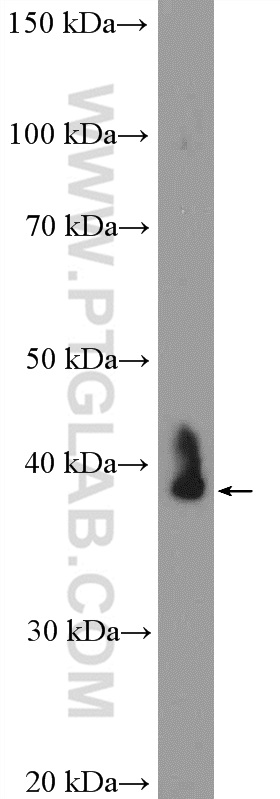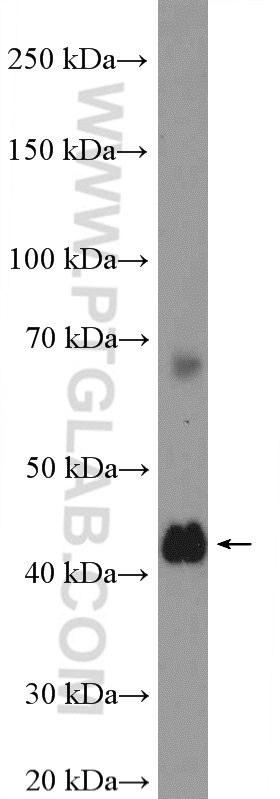验证数据展示
经过测试的应用
| Positive WB detected in | rat kidney tissue, HeLa cells, rat liver tissue, mouse liver tissue, human kidney tissue |
推荐稀释比
| 应用 | 推荐稀释比 |
|---|---|
| Western Blot (WB) | WB : 1:500-1:1000 |
| It is recommended that this reagent should be titrated in each testing system to obtain optimal results. | |
| Sample-dependent, Check data in validation data gallery. | |
发表文章中的应用
| WB | See 3 publications below |
产品信息
12874-1-AP targets RPP38 in WB, ELISA applications and shows reactivity with human, mouse, rat samples.
| 经测试应用 | WB, ELISA Application Description |
| 文献引用应用 | WB |
| 经测试反应性 | human, mouse, rat |
| 文献引用反应性 | human, rat |
| 免疫原 |
CatNo: Ag3552 Product name: Recombinant human RPP38 protein Source: e coli.-derived, PGEX-4T Tag: GST Domain: 1-283 aa of BC029494 Sequence: MAAAPQAPGRGSLRKTRPLVVKTSLNNPYIIRWSALESEDMHFILQTLEDRLKAIGLQKIEDKKKKNKTPFLKKESREKCSIAVDISENLKEKKTDAKQQVSGWTPAHVRKQLAIGVNEVTRALERRELLLVLVCKSVKPAMITSHLIQLSLSRSVPACQVPRLSERIAPVIGLKCVLALAFKKNTTDFVDEVRAIIPRVPSLSVPWLQDRIEDSGENLETEPLESQDRELLDTSFEDLSKPKRKLADGRQASVTLQPLKIKKLIPNPNKIRKPPKSKKATPK 种属同源性预测 |
| 宿主/亚型 | Rabbit / IgG |
| 抗体类别 | Polyclonal |
| 产品类型 | Antibody |
| 全称 | ribonuclease P/MRP 38kDa subunit |
| 别名 | RNaseP protein p38, RP11 455B2.5, RPP38 |
| 计算分子量 | 38 kDa |
| 观测分子量 | 38 kDa |
| GenBank蛋白编号 | BC029494 |
| 基因名称 | RPP38 |
| Gene ID (NCBI) | 10557 |
| RRID | AB_2285405 |
| 偶联类型 | Unconjugated |
| 形式 | Liquid |
| 纯化方式 | Antigen affinity purification |
| UNIPROT ID | P78345 |
| 储存缓冲液 | PBS with 0.02% sodium azide and 50% glycerol, pH 7.3. |
| 储存条件 | Store at -20°C. Stable for one year after shipment. Aliquoting is unnecessary for -20oC storage. |
实验方案
| Product Specific Protocols | |
|---|---|
| WB protocol for RPP38 antibody 12874-1-AP | Download protocol |
| Standard Protocols | |
|---|---|
| Click here to view our Standard Protocols |
发表文章
| Species | Application | Title |
|---|---|---|
Drug Des Devel Ther Effects of Uremic Clearance Granules on p38 MAPK/NF-κB Signaling Pathway, Microbial and Metabolic Profiles in End-Stage Renal Disease Rats Receiving Peritoneal Dialysis | ||
Eur J Pharmacol Tumoral EIF4EBP1 regulates the crosstalk between tumor-associated macrophages and tumor cells in MRTK | ||
Int Immunopharmacol Preventive effects of matrine on LPS-induced inflammation in RAW 264.7 cells and intestinal damage in mice through the TLR4/NF-κB/MAPK pathway |

